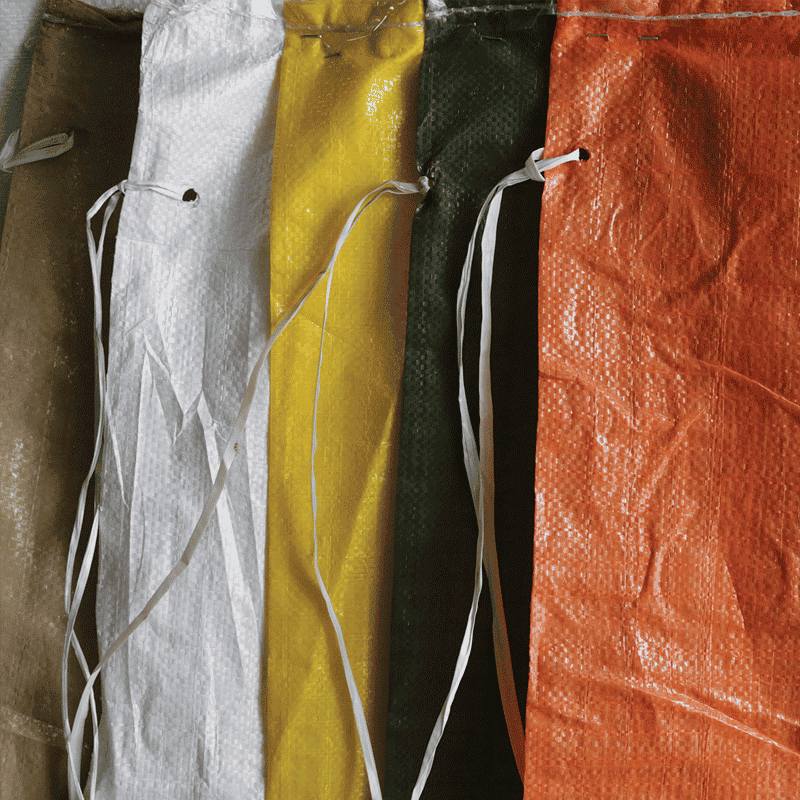Woven Polypropylene Sand Bags
Request A Quote
Description:
Our polypropylene Sand Bags are treated with 2000 hrs. UV resistance and made from 10×10 weave and 850 Denier. Bags are Hemmed Top mouth, single folded bottom double stitched. Bags come with a strong tie string and 1000 Bags in a Bale. These Sand Bags are available in different colors like White, Beige. Tan, Orange, Yellow and Green. Standard bags are 14” ×26” available in 5 colors. Larger 18” ×30” PP WOVEN bags come in white color.
Specifications: 14”×26” Polypropylene Sand Bag
| Property | Value |
|---|---|
| Product Code | En-SND-WPPMW14262000TIE-1 |
| Product | PP Woven Sandbags with tie strings, 2000 hours UV stabilized |
| Size | 14” x 26” |
| Mesh | 10 x 10 |
| Color | Milky White |
| Denier | 850 |
| Top | Hemmed |
| Bottom | Single Fold Double Stitched |
| Total Weight P/Pc | 39 grams +/-5% |
| Printing | Unprinted – also available with custom printed |
| Packaging | 1000 Pcs / Bale duty wrapped with PP Fabric and sewn at all ends |
Specifications: 18”×30” Polypropylene Sand Bag
| Property | Value |
|---|---|
| Product Code | En-SND-WPPMW18301M-1 |
| Product | PP Woven Sandbags, 400 hours UV |
| Size | 18” x 30” |
| Mesh | 10 x 10 |
| Color | Milky White |
| Denier | 850 |
| Top | Hemmed |
| Bottom | Single Fold Double Stitched |
| Total Weight P/Pc | 57 grams +/-5% |
| Printing | Unprinted |
| Packaging | 1000 Pcs / Bale duty wrapped with PP Fabric and sewn at all ends |
Commonly asked questions:
What are Polypropylene Sand Bags Used For?
These sand bags are used for flood mitigation, traffic control, and erosion control. They’re ideal for establishing berms, dikes, levees, and barricades to prevent damaging floodwaters from devastating nearby projects, soils, crops, buildings, and more. Water follows the path of least resistance; therefore, these bags will aid in the redirection of any flowing water.
They can be used to safeguard sewers, buildings, crossroads, crops, pastures, overflowing irrigation systems, riverbeds, and other sites. Our UV-resistant Polypropylene sand bags are built to withstand even the most difficult tasks.
Who uses Polypropylene sand bags?
Bags made of polypropylene are great for anyone who has a business in the construction or agriculture industries and would benefit from sand bags. These will assist in protecting outdoor workers by redirecting any running water away from specific places where crews are working, or flaggers are stationed. They’re also helpful for public workers trying to control rivers and streams, overflowing sewer systems, and other issues.
What Is Polypropylene?
Polypropylene, widely known as polypropene, is a thermoplastic material that has a wide variety of functions. It is generated from the monomer propylene through chain-growth polymerization.
Polypropylene is a non-polar, partly crystalline polyolefin that is related to the polyolefin class. It has similar attributes as polyethylene; however, it is a little stiffer and more heat tolerant. It is a white, chemically tough, and chemically resistant substance.
What is the difference between woven and non-woven bags?
Non-woven bags are typically manufactured. Instead of being woven, the fabric in non-woven bags is entangled. On the other hand, woven bags are created by weaving fabric together.
How long will these Polypropylene sand bags last?
Sand bags made of polypropylene usually last around a year. Ours have been reinforced with UV protection for 2000 hours, which means they can survive roughly 2000 hours of UV rays from the sun. Depending on how they’re cared for and what conditions they’re utilized in, they may last longer.
Where is the best place to store sand bags?
Store unused sand bags in a cool, dry area, preferably inside, when not in use. On the other hand, you should store any used sand bags off the ground and out of direct sunlight. It’s also a good idea to keep them covered, so they are protected from the elements. Our burlap and polypropylene tarps can be used for additional protection.
What is the best sand to use for sand bags?
Mason sand is the best type of sand to use in your Polypropylene sand bags. This is due to the fact that it is rinsed sand, which means there is no dust or grime in it. So, if a problem occurs and sand spills out of your sacks, the area will not get messy or contaminated. It’s the purest sand on the market.
How much does masonry sand cost?
Masonry sand ranges in price from $25 to $45 a ton. This amount will cover approximately 35 square feet when distributed about 1 inch thick throughout. Despite the title, masonry sand has many uses. In addition to masonry work, it can be used for grouting, playground sand, concrete blending, paving, or ground cover/stabilizer. Or, as we recommend, putting it in our sand bags.
Request A Quote
You can also call us at 619-429-9800
